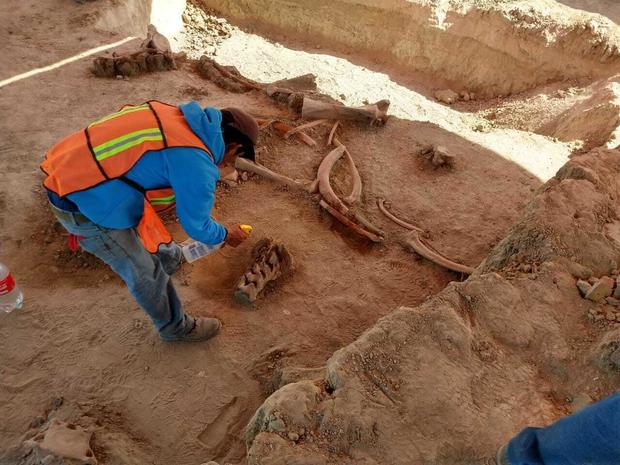Bones of about 60 mammoths found near ancient lake in Mexico
Skeletal remains of dozens of mammoths have been discovered at an airport construction site in Mexico, the country's National Institute of Anthropology and History (INAH) announced Thursday. The findings will give experts an "unprecedented opportunity to delve into more than 30,000 years of history," according to an English translation of a statement from the institute.
Bones from about 60 mammoths and 15 human burials were found near a former military base in Santa Lucia, where the new General Felipe Ángeles International Airport is under construction, INAH said. The institute opened 23 exploration fronts on the land around the future airport as part of an archaeological and paleontological rescue project that now has 30 archaeologists.
Pedro Francisco Sánchez Nava, INAH's national coordinator of archaeology, said that remains were found in three exploration areas and that archaeologists are still determining how many bones are complete. The digs began in October, and the team has found plenty of skeletal mammoth remains since — with possibly many more to go.
"There are too many, there are hundreds," Sánchez Nava told The Associated Press.
Much of the focus has been on shore of the ancient Lake Xaltocan. The mammoth skeletons discovered in what used to be the shallow part of the lake were better anatomically preserved than those found in deeper parts of the former lake, the INAH said. The mammoths — which included males, females and their young — likely died by getting stuck in the lake, which had varied depths and dried up into a swamp, the group added.
While the INAH doesn't think the mammoths were killed by humans, the group said it's possible that hunters took advantage of the heavy animals once they were stuck in the mud.
Scientists said the human burials were likely farmers from the pre-Hispanic period, because some were accompanied by pots, bowls and clay figurines. Some of the items are consistent with Aztec ceramics, and researchers believe the Aztecs were the last group to occupy the area.
Sánchez Nava said he wants to turn these areas into a museum where travelers can learn about mammoths, the evolution of the region and construction of the country.
"The history of Lake Xaltocan and the region of Santa Lucia is fascinating," he said.






